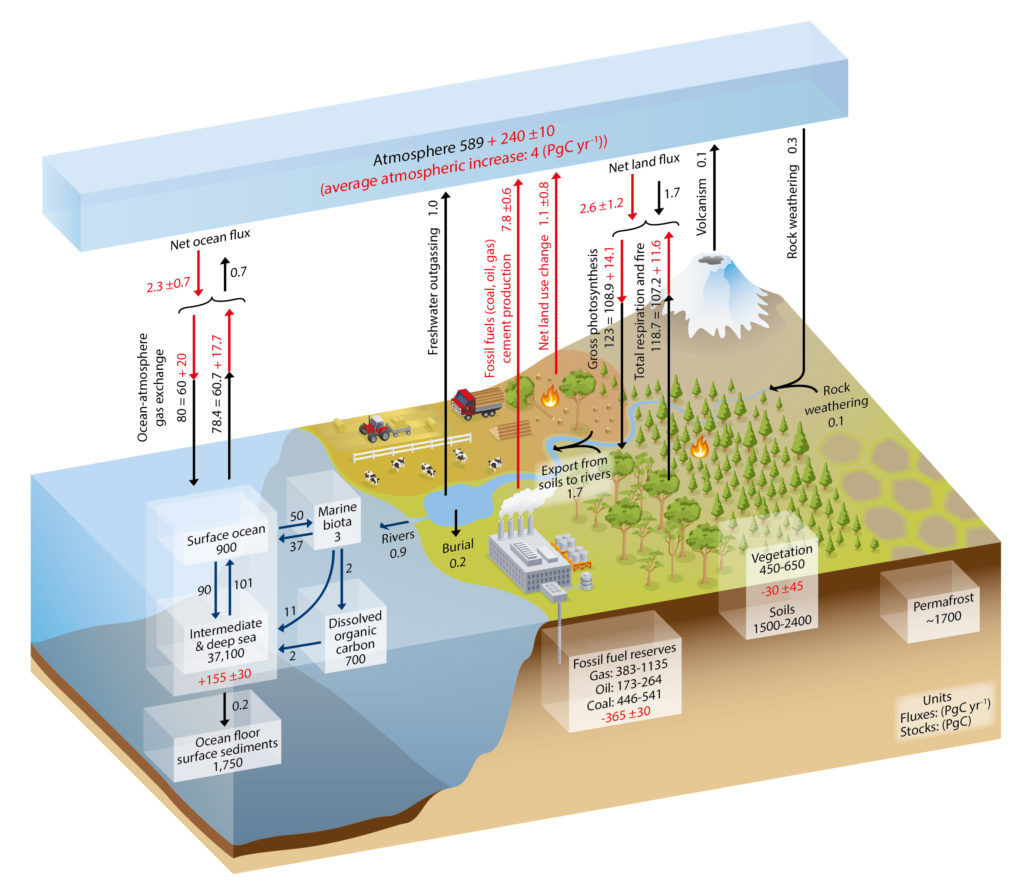Carbon cycle

|
| IPCC Report AR5 Climate Change 2013: The Physical Science Basis, Chapter 6: Carbon and Other Biogeochemical Cycles fig 6.1 |
Contents |
Definition
AR5 Climate Change 2014: Impacts, Adaptation, and Vulnerability, Glossary, published by the Intergovernmental Panel on Climate Change (IPCC) defines the carbon cycle as: ‘...the flow of carbon (in various forms, e.g., as carbon dioxide) through the atmosphere, ocean, terrestrial and marine biosphere, and lithosphere.... the reference unit for the global carbon cycle is GtC or equivalently PgC (10^15g).’
Slow and fast domain carbon cycles
The IPCC distinguishes between slow carbon cycles of beyond 10,000 years, and those of 1–100 years and 10–500 years, known as fast carbon cycles.
Geological carbon cycles
The lithosphere carbon cycle, also known as the geological carbonate–silicate cycle is fully part of the slow carbon cycle and describes inert carbon in the lithosphere, much of which being the Earth's mantle from the beginnings of the Earth, with some from organic biosphere carbon. 80% is stored in limestone and in the calcium carbonate stored in the shells.
Oceanic carbon cycles
The oceanic or marine cycles cover both fast and slow cycles, with what is called the deep layer, a few hundred meters down, below the intermediate layer, this runs on carbon cycles over centuries or more, transferring carbon from the oceans to the floor of the ocean into sediments and the slow transfer to rock formations. The surface and intermediate layers of the oceanic cycle exchange carbon between marine biota, dissolved organic carbon (DOC) and dissolved in-organic carbon (DIC) over shorter cycles as well as between the ocean surface and the atmosphere on daily cycles.
Atmospheric carbon cycles
The atmospheric carbon cycle runs of fast cycles exchanging gaseous carbon compounds, primarily carbon dioxide (CO2), as well as methane (CH4), carbon monoxide (CO), and other man-made compounds between Earth's atmosphere, the oceans, and the terrestrial biosphere. Atmospheric concentrations of CO2 can remain stable over longer periods when a balance between flows exists. The burning of fossil fuels transfers carbon from the slow domain to the fast domain. Replenishment of carbon released from burning fossil fuels (and other terrestrial changes) through natural biogenic processes cannot occur quickly enough to rebalance the system, thus causing temperature rise.
Terrestrial biological carbon cycle
The terrestrial biological carbon cycle is the final and possibly most relevant cycle to human beings as this describes the fast domain cycle of carbon exchange relating to all land-living organisms both dead and alive, as well as in soils. This might also be referred to as the biogenic energy cycle as it refers to a system in balance between living things on Earth in the biosphere and its impacts on the atmosphere. It is also the result of changes in this balance caused by human activities resulting in imbalance in the system leading to temperature rise and climate change.
Related articles on Designing Buildings
Featured articles and news
RTPI leader to become new CIOB Chief Executive Officer
Dr Victoria Hills MRTPI, FICE to take over after Caroline Gumble’s departure.
Social and affordable housing, a long term plan for delivery
The “Delivering a Decade of Renewal for Social and Affordable Housing” strategy sets out future path.
A change to adoptive architecture
Effects of global weather warming on architectural detailing, material choice and human interaction.
The proposed publicly owned and backed subsidiary of Homes England, to facilitate new homes.
How big is the problem and what can we do to mitigate the effects?
Overheating guidance and tools for building designers
A number of cool guides to help with the heat.
The UK's Modern Industrial Strategy: A 10 year plan
Previous consultation criticism, current key elements and general support with some persisting reservations.
Building Safety Regulator reforms
New roles, new staff and a new fast track service pave the way for a single construction regulator.
Architectural Technologist CPDs and Communications
CIAT CPD… and how you can do it!
Cooling centres and cool spaces
Managing extreme heat in cities by directing the public to places for heat stress relief and water sources.
Winter gardens: A brief history and warm variations
Extending the season with glass in different forms and terms.
Restoring Great Yarmouth's Winter Gardens
Transforming one of the least sustainable constructions imaginable.
Construction Skills Mission Board launch sector drive
Newly formed government and industry collaboration set strategy for recruiting an additional 100,000 construction workers a year.
New Architects Code comes into effect in September 2025
ARB Architects Code of Conduct and Practice available with ongoing consultation regarding guidance.
Welsh Skills Body (Medr) launches ambitious plan
The new skills body brings together funding and regulation of tertiary education and research for the devolved nation.
Paul Gandy FCIOB announced as next CIOB President
Former Tilbury Douglas CEO takes helm.
UK Infrastructure: A 10 Year Strategy. In brief with reactions
With the National Infrastructure and Service Transformation Authority (NISTA).






















